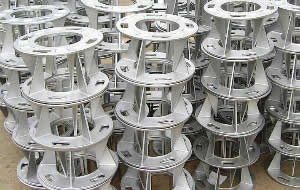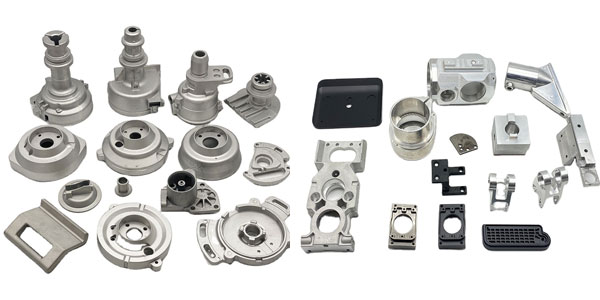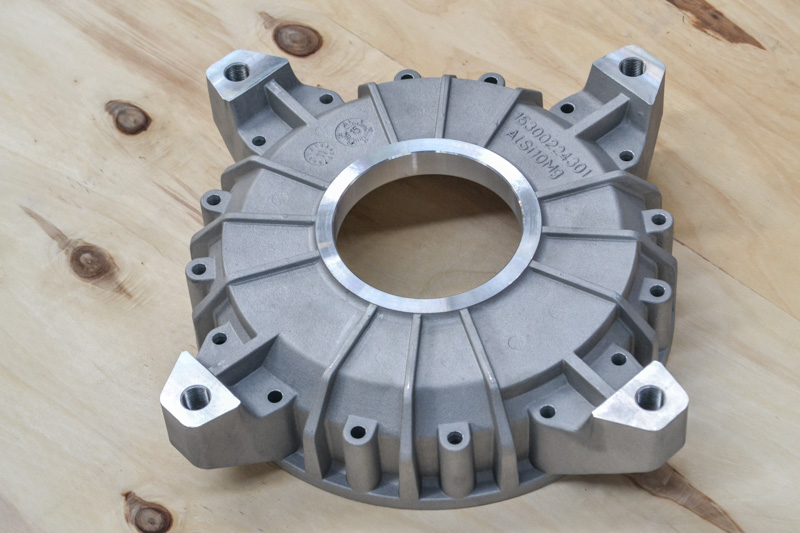Discovering the Versatile Uses and Applications of Light Weight Aluminum Castings in Modern Industries
Aluminum spreadings have ended up being essential to different contemporary markets because of their one-of-a-kind homes. They supply significant benefits in weight decrease, thermal conductivity, and deterioration resistance. From auto technologies to applications in customer goods and building and construction, their convenience is amazing. The true extent of their influence extends past immediate advantages, hinting at wider effects for sustainability and efficiency. What lies ahead for light weight aluminum spreadings in an ever-evolving commercial landscape?
Automotive Market Innovations
The auto market has actually significantly embraced aluminum spreadings to improve car performance and efficiency. By utilizing aluminum, manufacturers can generate lighter parts, which add to improved fuel economy and minimized discharges. Trick applications include engine blocks, transmission situations, and architectural parts, where the product's strength-to-weight ratio supplies resilience without adding excess weight.
Aluminum castings likewise supply superior thermal conductivity, which assists in better heat dissipation, therefore enhancing engine performance. Developments in casting innovations, such as die casting and sand casting, allow the production of complex geometries, enabling for ingenious designs that enhance room and functionality.
The recyclability of aluminum straightens with sustainability goals in the vehicle field, advertising environmentally friendly practices. As the market continues to introduce, using aluminum castings is likely to expand, driving more advancements in vehicle design and efficiency.
Aerospace Improvements and applications
While the aerospace sector remains to focus on weight reduction and gas efficiency, aluminum spreadings have become a vital material option for various applications. Their lightweight nature, combined with high strength-to-weight ratios, permits for significant improvements in airplane efficiency and performance. Aluminum spreadings are generally utilized in structural elements, such as body frames and wing parts, where lowering weight is vital.
Current advancements in aluminum casting modern technologies, consisting of enhanced alloy formulations and precision casting techniques, have actually further improved the material's performance abilities. These technologies enable the production of complicated geometries and complex styles while preserving architectural honesty. Additionally, aluminum's superb rust resistance guarantees durability and dependability in harsh aerospace atmospheres.
As the aerospace field increasingly accepts sustainability, aluminum castings provide a recyclable option that lines up with green practices, making them a critical component in the development of next-generation aircraft.
Customer Product and Everyday Products
As consumers significantly seek lightweight yet long lasting materials for day-to-day items, aluminum spreadings have obtained popularity in different durable goods. The unique residential or commercial properties of aluminum, including its resistance to corrosion and excellent thermal conductivity, make it a suitable choice for things like cooking equipment, house devices, and exterior equipment. For example, aluminum cast pans and pots offer also warmth distribution, improving cooking performance. Additionally, making use of light weight aluminum in items such as bicycle structures and baggage guarantees an equilibrium in between strength and mobility. Manufacturers appreciate aluminum spreadings for their flexibility, as they can be easily built right into complex forms while keeping structural honesty. The capability to reuse aluminum without degrading its properties aligns with expanding customer choices for sustainable items. Generally, aluminum castings are essential to the manufacturing of durable, useful, and visually pleasing consumer goods, fulfilling the needs of modern-day lifestyles.
Building And Construction and Architectural Makes Use Of
Light weight aluminum castings have actually become an important element in building and building design, particularly due to their stamina and light-weight nature. These buildings make aluminum an optimal option for numerous applications, including architectural components, facades, and decorative attributes - Aluminum Castings. Building contractors and architects increasingly make use of aluminum spreadings for window frames, doors, and roof, enhancing both capability and aesthetics. The material's resistance to deterioration better prolongs its lifespan, lowering maintenance expenses and ensuring toughness in diverse environmental problems
Furthermore, light weight aluminum can be quickly built into elaborate styles, permitting for innovative architectural expressions. Its versatility assists in the creation of customized items that satisfy particular style requirements, from ornate barriers to complex assistances. As sustainability comes to be a priority, aluminum's recyclability adds to its appeal in environment-friendly construction techniques. Overall, aluminum spreadings are transforming the construction market by offering lightweight, durable, and visually appealing solutions.
Electric and Electronic Parts
Aluminum spreadings play an essential function in the manufacturing of light-weight electric rooms, which improve transportability and efficiency in numerous applications. Furthermore, their outstanding thermal conductivity makes them optimal for warm sinks, making sure peak performance and long life of digital parts. Light weight aluminum's conductive homes contribute to its usage in different electric conductors, stressing its value in modern-day innovation.
Light-weight Electrical Rooms
Light-weight electric units play a vital function in protecting sensitive digital parts from environmental factors and physical damages. Constructed from aluminum spreadings, these enclosures are valued for their strength-to-weight proportion, making them suitable for various applications across industries. Their light-weight nature help in lowering overall system weight, which is essential in portable and mobile electronic devices. Furthermore, light weight aluminum's rust resistance boosts durability, expanding the lifespan of the encased components. The capability to mold and mildew light weight aluminum into complex forms permits tailored designs, providing to certain needs while making certain effective warmth dissipation. Furthermore, these rooms can be easily integrated right into existing systems, providing adaptability and versatility in contemporary technological settings. On the whole, light-weight aluminum rooms considerably add to the efficiency of electronic gadgets.
Warm Sinks and Conductors
While lots of materials are utilized in electronic elements, light weight aluminum spreadings attract attention for their efficiency in warm administration as warmth sinks and conductors. Their superb thermal conductivity enables effective warm dissipation, which is important in protecting against the overheating of electronic gadgets. Light weight aluminum's light-weight nature better enhances its viability for applications where weight is a substantial aspect, such as in aerospace and automotive industries. In addition, aluminum spreadings can be conveniently molded into complex shapes, offering style versatility for enhancing thermal performance. The deterioration resistance of light weight aluminum additionally contributes to the longevity and reliability of these components in numerous environments. As technology advancements and gadgets end up being a lot more compact, the need for effective warm monitoring remedies, like light weight aluminum spreadings, remains to grow.
Marine Market Use
The aquatic industry significantly depends on light weight aluminum spreadings for their phenomenal durability and rust resistance. These residential or commercial properties make light weight aluminum an excellent choice for various applications, consisting of boat hulls, engine elements, and aquatic hardware. The light-weight nature of light weight aluminum castings allows improved fuel efficiency and much easier maneuverability in watercraft, which is necessary for both industrial and entertainment vessels.

Light weight aluminum castings also provide substantial cost advantages because of their long life-span and reduced upkeep demands, lowering the general functional costs for marine operators. Additionally, the flexibility of aluminum enables detailed designs that can satisfy certain performance requirements.
Makers in the marine sector utilize innovative spreading techniques to produce complex shapes, making sure that components fulfill extensive safety and security and efficiency criteria. As the demand for high-performance aquatic vessels expands, aluminum castings are placed as a crucial product in enhancing the functionality and longevity of aquatic devices.
Sustainability and Recycling in Light Weight Aluminum Casting

Aluminum Recycling Process
Reusing aluminum plays a necessary role in lessening ecological impact and saving sources within the casting industry. The aluminum recycling procedure begins with the collection of scrap aluminum, which can consist of old parts, manufacturing waste, and post-consumer products. This scrap is after that arranged, cleaned, and shredded right into tiny items more helpful hints to help with melting.
Once prepared, the aluminum scrap is thawed in a heater at reduced temperatures than main light weight aluminum manufacturing, substantially lowering energy consumption. The liquified light weight aluminum is after that cast right into ingots or various other shapes for reuse in numerous applications - Metal Castings. This closed-loop system permits the reliable healing of aluminum, protecting its residential or commercial properties while reducing the need for virgin products. As a result, the reusing process is a critical element of lasting practices in aluminum casting
Environmental Benefits
While light weight aluminum spreading plays a crucial duty in numerous industries, its environmental benefits are especially remarkable relating to sustainability and resource preservation. The light-weight nature of light weight aluminum adds to power efficiency in transportation, minimizing fuel usage and discharges. Furthermore, light weight aluminum spreading assists in the usage of recycled materials, considerably reducing the energy needed for manufacturing compared to primary light weight aluminum. This reusing process decreases waste and lessens the ecological influence related to mining and refining basic materials. Furthermore, light weight aluminum is 100% recyclable without deterioration of its residential or commercial properties, promoting a sustainable lifecycle. By choosing aluminum casting, industries can significantly lower their carbon impact while advertising resource efficiency, making it an important option in the search of environmentally friendly manufacturing techniques.
Closed-Loop Systems

Regularly Asked Questions
What Are the Trick Perks of Aluminum Castings Over Other Materials?
Light weight aluminum spreadings supply lightweight buildings, outstanding deterioration resistance, and high strength-to-weight ratios. They can be quickly molded into intricate forms, provide great thermal and electric conductivity, and are cost-efficient, making them preferable over lots of different products.
Exactly how Is the Light Weight Aluminum Casting Refine Environmentally Friendly?
The aluminum spreading process is ecologically pleasant due to its recyclability, low power usage, and decreased waste manufacturing. Its capacity to utilize recycled products minimizes the carbon impact, promoting sustainability within manufacturing methods.
What Are Usual Obstacles in Light Weight Aluminum Spreading Production?
Usual obstacles in aluminum casting manufacturing consist of keeping dimensional precision, handling thermal tightening, protecting against flaws like porosity and additions, ensuring appropriate mold and mildew design, and enhancing manufacturing effectiveness while decreasing product waste and environmental influence.
Just How Do Aluminum Castings Contrast in Expense With Other Manufacturing Methods?
Light weight aluminum spreadings generally supply affordable costs compared to various other making methods, particularly for medium to high-volume manufacturing. Their lower preliminary tooling costs and efficient material usage can cause desirable business economics with time.
What Future Fads Are Expected in Light Weight Aluminum Casting Innovation?
Future patterns in aluminum casting technology are prepared for to consist of advancements in automation, boosted alloy make-ups, improved recycling approaches, and the combination of 3D printing, all intended at enhancing efficiency, decreasing expenses, and minimizing ecological effect.
Current innovations in light weight aluminum spreading technologies, consisting of improved alloy formulas and accuracy spreading methods, have actually further boosted the material's efficiency abilities. Light weight aluminum castings have actually come to be a necessary part in building and construction and building design, especially due to their toughness and lightweight nature. The Clicking Here light weight aluminum reusing procedure starts with the collection of scrap light weight aluminum, which can include old parts, producing waste, and post-consumer products. As soon as prepared, the aluminum scrap is thawed in a furnace at lower temperatures than primary aluminum manufacturing, significantly lowering power usage. Additionally, aluminum casting assists in the use of recycled materials, greatly lowering try this out the power needed for manufacturing contrasted to key aluminum.